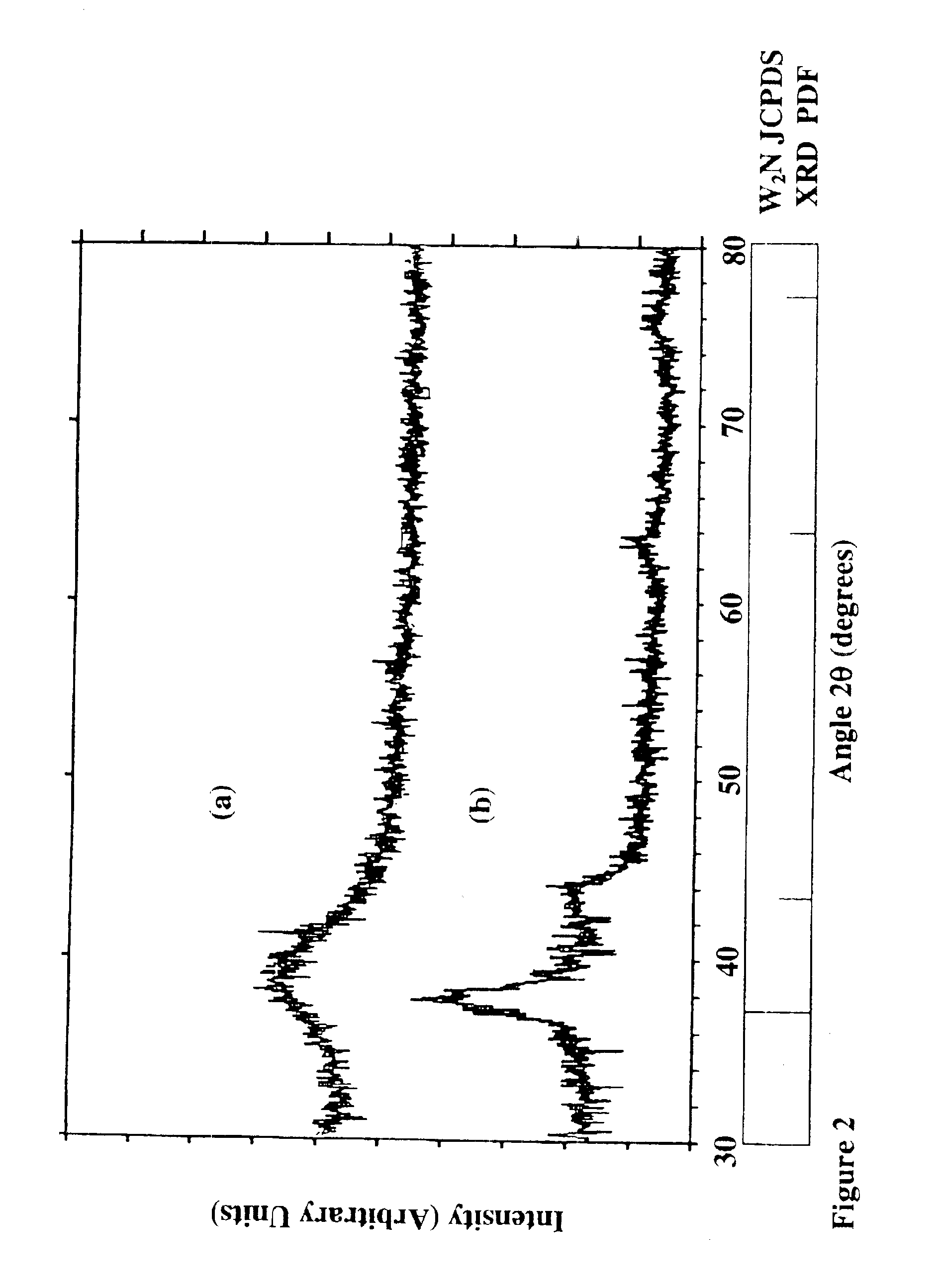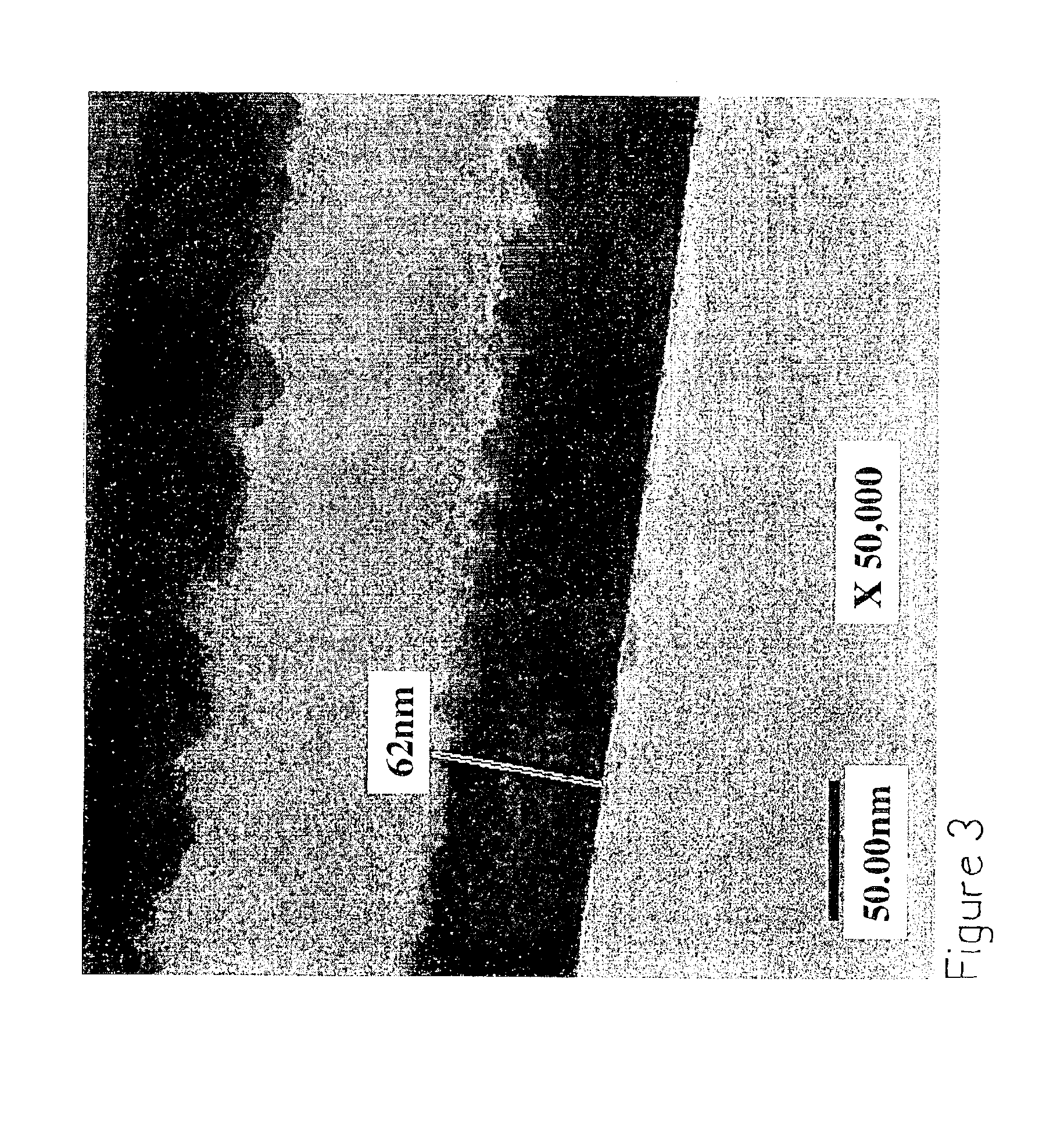Process for low-temperature metal-organic chemical vapor deposition of tungsten nitride and tungsten nitride films
a technology of metal-organic chemical vapor deposition and tungsten nitride, which is applied in the direction of coatings, chemistry apparatus and processes, layered products, etc., can solve the problems of limited application of sputtering techniques, further complicated needs, and inability to achieve high conformality with low impurities
- Summary
- Abstract
- Description
- Claims
- Application Information
AI Technical Summary
Benefits of technology
Problems solved by technology
Method used
Image
Examples
example 1
[0102]An alpha-type, 200 mm-wafer, cold-wall, plasma-capable CVD reactor, equipped with a high vacuum loadlock for wafer transport and handling was used in this Example. The use of the loadlock system allowed for tight control over the cleanliness of the CVD chamber, and prevented undesirable contamination from exposure to ambient conditions during sample loading and unloading. In addition, a cryogenic pump was used to routinely achieve a chamber base pressure at about 10−6 torr, while a roots blower pumping stack was used during actual growth runs. The precursor was placed in a reservoir heated to temperatures ranging from 85 to 100° C., depending on the processing conditions, and the precursor flow rate into the reactor was regulated by an MKS 1153 solid source delivery system (SSDS). The SSDS and all delivery lines were heated to 120° C. to prevent precursor recondensation.
[0103]Parallel plate, radio-frequency plasma (13.56 MHz) capability was used for in situ, pre-deposition, wa...
example 2
[0113]In this Example, the same procedures were used as described above in Example 1 in detail with the exception that in this Example, thermal deposition of a number of tungsten nitride films was carried out using a stand-alone single module deposition chamber and reacting tungsten hexacarbonyl with ammonia in the presence of hydrogen gas. The reaction parameters are shown below in Table 2.
[0114]
TABLE 2Parameter NameParameter in Example 2Substrate Temperature220° C.Ammonia Flow Rate 100 standard cm3 / minHydrogen Flow Rate 50 standard cm3 / minProcess Pressure0.5 torrPrecursor Flow Rate18.7 standard cm3 / minDeposition Rate2 nm / min
[0115]Using the above parameters, the following tests as set forth in Table 3 below, which are described in further detail in Example 1 were carried out and demonstrate that amorphous W2N films were formed with less than about 5 at % hydrogen, about 5-8 at % oxygen, and about 4-6 at % carbon. The relevant representative spectra for this Example are shown in FI...
example 3
[0117]In this Example, the procedure of Example 1 was followed with the exception that thermal CVD of tungsten nitride films was undertaken using a cluster tool platform. The reactants were tungsten hexacarbonyl and ammonia. The reaction conditions are shown below in Table 4.
[0118]
TABLE 4Parameter NameParameter in Example 3Substrate Temperature225° C.Ammonia Flow Rate150 standard cm3 / minHydrogen Flow Rate—Process Pressure0.5 torrPrecursor Flow Rate 20 standard cm3 / minDeposition Rate4 nm / min
[0119]The resulting films and coated substrates formed using the above parameters were tungsten nitride films of varied compositions within the formula WNx where 0.1≦x≦2.0. The oxygen and carbon impurities were less than about 1-3 at % O and less than about 1-2 at % carbon with no hydrogen. The resulting phases of the different films varied from amorphous to amorphous with partial polycrystallinity in a β-phase. FIGS. 11-14 show the characteristics of the films. The resisitivities were measured to...
PUM
| Property | Measurement | Unit |
|---|---|---|
| temperature | aaaaa | aaaaa |
| temperature | aaaaa | aaaaa |
| temperature | aaaaa | aaaaa |
Abstract
Description
Claims
Application Information
 Login to View More
Login to View More - R&D
- Intellectual Property
- Life Sciences
- Materials
- Tech Scout
- Unparalleled Data Quality
- Higher Quality Content
- 60% Fewer Hallucinations
Browse by: Latest US Patents, China's latest patents, Technical Efficacy Thesaurus, Application Domain, Technology Topic, Popular Technical Reports.
© 2025 PatSnap. All rights reserved.Legal|Privacy policy|Modern Slavery Act Transparency Statement|Sitemap|About US| Contact US: help@patsnap.com



